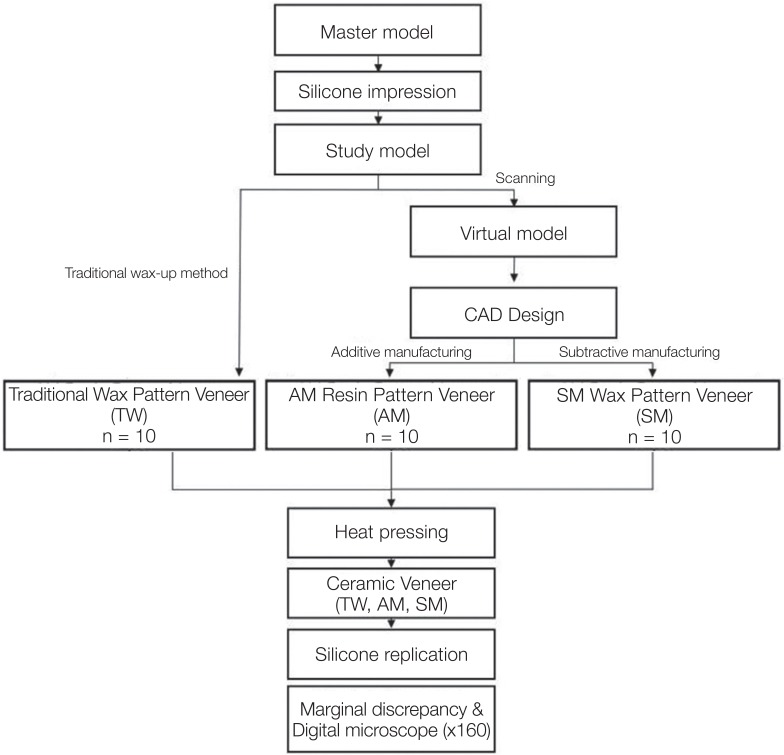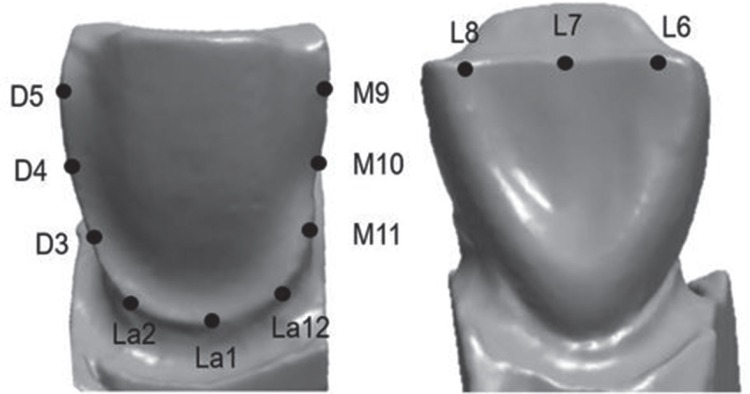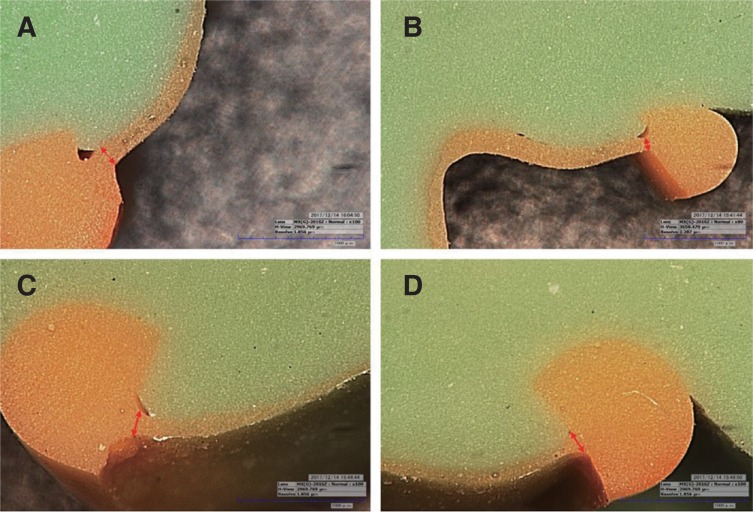J Adv Prosthodont.
2018 Oct;10(5):347-353. 10.4047/jap.2018.10.5.347.
Evaluation of marginal discrepancy of pressable ceramic veneer fabricated using CAD/CAM system: Additive and subtractive manufacturing
- Affiliations
-
- 1Department of Dental Laboratory Science and Engineering, College of Health Science, Korea University, Seoul, Republic of Korea. kuc2842@korea.ac.kr
- KMID: 2422870
- DOI: http://doi.org/10.4047/jap.2018.10.5.347
Abstract
- PURPOSE
The purpose of this study was to evaluate the marginal discrepancy of heat-pressed ceramic veneers manufactured using a CAD/CAM system.
MATERIALS AND METHODS
The ceramic veneers for the abutment of a maxillary left central incisor were designed using a CAD/CAM software program. Ten veneers using a micro-stereolithography apparatus (AM group), ten veneers using a five-axis milling machine (SM group), and ten veneers using a traditional free-hand wax technique (TW group) were prepared according to the respective manufacturing method. The ceramic veneers were also fabricated using a heat-press technique, and a silicone replica was used to measure their marginal discrepancy. The marginal discrepancies were measured using a digital microscope (×160 magnification). The data were analyzed using a nonparametric Kruskal-Wallis H test. Finally, post-hoc comparisons were conducted using Bonferroni-corrected Mann-Whitney U tests (α=.05).
RESULTS
The mean±SD of the total marginal discrepancy was 99.68±28.01 µm for the AM group, 76.60±28.76 µm for the SM group, and 83.08±39.74 µm for the TW group. There were significant differences in the total marginal discrepancies of the ceramic veneers (P < .05).
CONCLUSION
The SM group showed a better fit than the AM and TW groups. However, all values were within the clinical tolerance. Therefore, CAD/CAM manufacturing methods can replace the traditional free-hand wax technique.
Keyword
Figure
Reference
-
1. Marchionatti AME, Wandscher VF, May MM, Bottino MA, May LG. Color stability of ceramic laminate veneers cemented with light-polymerizing and dual-polymerizing luting agent: A split-mouth randomized clinical trial. J Prosthet Dent. 2017; 118:604–610. PMID: 28385431.
Article2. Peumans M, De Munck J, Fieuws S, Lambrechts P, Vanherle G, Van Meerbeek B. A prospective ten-year clinical trial of porcelain veneers. J Adhes Dent. 2004; 6:65–76. PMID: 15119590.3. Aboushelib MN, Elmahy WA, Ghazy MH. Internal adaptation, marginal accuracy and microleakage of a pressable versus a machinable ceramic laminate veneers. J Dent. 2012; 40:670–677. PMID: 22542500.
Article4. Shamseddine L, Mortada R, Rifai K, Chidiac JJ. Fit of pressed crowns fabricated from two CAD-CAM wax pattern process plans: A comparative in vitro study. J Prosthet Dent. 2017; 118:49–54. PMID: 28024815.5. Ural C, Burgaz Y, Saraç D. In vitro evaluation of marginal adaptation in five ceramic restoration fabricating techniques. Quintessence Int. 2010; 41:585–590. PMID: 20614046.6. Homsy FR, Özcan M, Khoury M, Majzoub ZAK. Marginal and internal fit of pressed lithium disilicate inlays fabricated with milling, 3D printing, and conventional technologies. J Prosthet Dent. 2018; 119:783–790. PMID: 28969918.
Article7. van Noort R. The future of dental devices is digital. Dent Mater. 2012; 28:3–12. PMID: 22119539.
Article8. Stampfl J, Baudis S, Heller C, Liska R, Neumeister A, Kling R, Ostendorf A, Spitzbart M. Photopolymers with tunable mechanical properties processed by laser-based high-resolution stereolithography. J Micromech Microeng. 2008; 18:125014.
Article9. Hamza TA, Ezzat HA, El-Hossary MM, Katamish HA, Shokry TE, Rosenstiel SF. Accuracy of ceramic restorations made with two CAD/CAM systems. J Prosthet Dent. 2013; 109:83–87. PMID: 23395333.
Article10. Neves FD, Prado CJ, Prudente MS, Carneiro TA, Zancopé K, Davi LR, Mendonça G, Cooper LF, Soares CJ. Micro-computed tomography evaluation of marginal fit of lithium disilicate crowns fabricated by using chairside CAD/CAM systems or the heat-pressing technique. J Prosthet Dent. 2014; 112:1134–1140. PMID: 24969409.11. Lin TM, Liu PR, Ramp LC, Essig ME, Givan DA, Pan YH. Fracture resistance and marginal discrepancy of porcelain laminate veneers influenced by preparation design and restorative material in vitro. J Dent. 2012; 40:202–209. PMID: 22198195.
Article12. Park JY, Bae SY, Lee JJ, Kim JH, Kim HY, Kim WC. Evaluation of the marginal and internal gaps of three different dental prostheses: comparison of the silicone replica technique and three-dimensional superimposition analysis. J Adv Prosthodont. 2017; 9:159–169. PMID: 28680546.
Article13. Kim DY, Jeon JH, Kim JH, Kim HY, Kim WC. Reproducibility of different arrangement of resin copings by dental microstereolithography: Evaluating the marginal discrepancy of resin copings. J Prosthet Dent. 2017; 117:260–265. PMID: 27646792.
Article14. Sakornwimon N, Leevailoj C. Clinical marginal fit of zirconia crowns and patients' preferences for impression techniques using intraoral digital scanner versus polyvinyl siloxane material. J Prosthet Dent. 2017; 118:386–391. PMID: 28222872.
Article15. Association AD. ANSI/ADA Specification No. 8 for zinc phosphate cement. Guide to dental materials and devices. 5th ed. Chicago: ADA;p. 1970–1971.16. Sulaiman F, Chai J, Jameson LM, Wozniak WT. A comparison of the marginal fit of In-Ceram, IPS Empress, and Procera crowns. Int J Prosthodont. 1997; 10:478–484. PMID: 9495168.17. McLean JW, von Fraunhofer JA. The estimation of cement film thickness by an in vivo technique. Br Dent J. 1971; 131:107–111. PMID: 5283545.
Article18. Vojdani M, Torabi K, Farjood E, Khaledi A. Comparison the Marginal and Internal Fit of Metal Copings Cast from Wax Patterns Fabricated by CAD/CAM and Conventional Wax up Techniques. J Dent (Shiraz). 2013; 14:118–129. PMID: 24724133.
- Full Text Links
- Actions
-
Cited
- CITED
-
- Close
- Share
- Similar articles
-
- Comparative evaluation of the subtractive and additive manufacturing on the color stability of fixed provisional prosthesis materials
- Marginal and internal discrepancy of 3-unit fixed dental prostheses fabricated by subtractive and additive manufacturing
- Marginal fit of the digident CAD/CAM zirconia ceramic crowns
- A case of digital maxillary complete denture and mandibular implant overdenture fabricated by CAD-CAM technique
- Evaluation of marginal and internal gap of three-unit metal framework according to subtractive manufacturing and additive manufacturing of CAD/CAM systems





